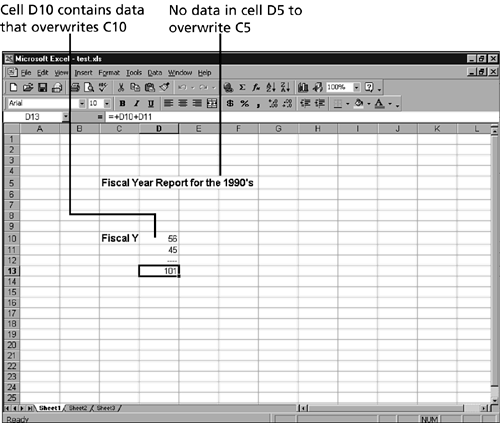Entering Worksheet Data
| Often, entering worksheet data requires nothing more than moving the cell pointer to the correct cell and typing the data. The various kinds of data behave differently when entered, however, so you should understand how Excel accepts assorted data. Excel can work with the following kinds of data:
Excel works well with data from other Office products. Additionally, you can import (transfer) data from other non-Microsoft products, such as Lotus 1-2-3. Entering TextIf you want to put text (such as a title or a name ) in a cell, just place your cursor in the cell and type the text. Excel left-justifies the text in the cell. As you type, the text appears both in the cell and in the Formula bar. Remember that the Name box to the left of the Formula bar displays the name of the cell into which you are entering data. When you press Enter, Excel moves the cell pointer down one row.
If you press Esc at any point during your text entry, Excel erases the text you typed in the cell and restores the original cell contents. If your text is wider than the cell, Excel does one of two things depending on the contents of the adjacent cell to the right:
Figure 43.5 shows two long labels (label is another name for text data) in cells C5 and C10. The same label, which is longer than standard cell width, appears in both cells . Because no data resides in D5, Excel displays all the contents of C5. The data in D10, however, overwrites the tail end of C10. C10 still contains the complete label, but only part of it is visible. Figure 43.5. Excel may or may not display all of a cell's contents.
Some text data, such as price codes, telephone numbers, and ZIP codes, fool Excel. As you see in the next section, Excel treats numeric data differently from text data when you type the data into cells. If you want Excel to treat a number (such as a ZIP code) as a text entry (calculations are not performed on the cell), precede the contents with a single apostrophe ('). For example, to type the ZIP code 74137, type '74137 ; the apostrophe lets Excel know to format the value as text. Entering NumbersExcel accepts numeric values of all kinds. You can type positive numbers, negative numbers, numbers with decimal points, zero-leading numbers, numbers with dollar signs, percent signs, and even scientific notation (a shortcut for writing extremely large and small numbers). Later in the section "Entering Values," you will learn more about how to put numeric values in worksheet cells.
Excel right-justifies numbers inside cells. You can change the format for a single cell or for the entire worksheet. Entering Dates and TimesExcel supports almost every national and international date and time format. Excel uses its AutoFormat feature to convert any date or time value that you type to a special internal number that represents the number of days since midnight, January 1, 1900. Excel automatically displays all dates the user enters with four-digit year values by showing the full year. Although this strange internal representation might not make sense now, you use these values a lot to compute time between two or more dates. You can easily determine how many days an account is past due, for example.
You can type any of the following date and time values to represent 6:15 p.m., July 4, 1976, or a combination of both 6:15 p.m. and July 4, 1976: July 4, 1976 4-Jul-76 6:15 p.m. 6:15 p.m. 18:15 07/04/76 18:15 07-04-76 18:15 If you enter any of these date and time values, Excel converts them to a shortened format (such as 7/4/76 18:15 ). You can enter a date, a time value, or both. As with most Office formats, you can change this default format with the Format menu. The shorter format often helps worksheet columns align better. |
EAN: 2147483647
Pages: 474
